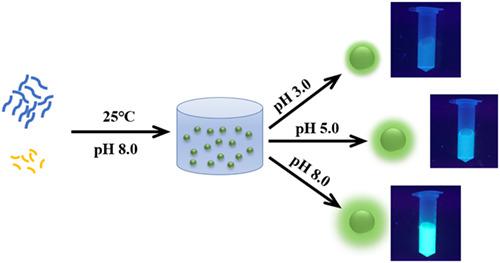当前位置:
X-MOL 学术
›
Luminescence
›
论文详情
Our official English website, www.x-mol.net, welcomes your feedback! (Note: you will need to create a separate account there.)
Coassemble dopamine and GHK tripeptide into fluorescent nanoparticles for pH sensing
Luminescence ( IF 2.9 ) Pub Date : 2020-06-29 , DOI: 10.1002/bio.3907 Fan Zheng 1 , Jun Guo 2 , Abdul Jamil Khan 1 , Pandeng Miao 1, 2 , Feng Zhang 1, 3
Luminescence ( IF 2.9 ) Pub Date : 2020-06-29 , DOI: 10.1002/bio.3907 Fan Zheng 1 , Jun Guo 2 , Abdul Jamil Khan 1 , Pandeng Miao 1, 2 , Feng Zhang 1, 3
Affiliation

|
Fluorescent nanostructures have been widely applied to biomedical researches and clinical diagnosis such as biolabeling/imaging/sensing and have even acted as therapy reagents. Peptide‐based fluorescent nanostructures attract recent interest from biomedical researchers. Inspired by the natural existence of GHK‐Cu complex with a growth factor‐like effect in human blood, here we have developed a novel approach for designing nanosensors through the co‐assembling of two kinds of biomolecules. By making best use of both π‐π stacking between carbon rings and the easy‐oxidation property of an important transmitter molecule, dopamine (DA), we successfully built up a supersensitive and robust fluorescent pH nanosensor by co‐assembling oxidized DA (DAox) with a tripeptide GHK. The GHK‐DAox nanostructures have a quantum yield of 20.82%, which might be the brightest one among all the current co‐assembling structures merely through unmodified biomolecules. We envision this approach could open a new avenue for not only hybrid nanostructure construction, but also may inspire the bioengineering of in vivo luminescent probes.
中文翻译:

将多巴胺和GHK三肽共组装到荧光纳米颗粒中以进行pH传感
荧光纳米结构已被广泛应用于生物医学研究和临床诊断,例如生物标记/成像/传感,甚至用作治疗试剂。基于肽的荧光纳米结构吸引了生物医学研究人员的近期兴趣。受GHK-Cu配合物在人类血液中天然存在并具有类生长因子作用的启发,在这里,我们开发了一种通过两种生物分子共同组装来设计纳米传感器的新颖方法。通过充分利用碳环之间的π-π堆积以及重要的递质分子多巴胺(DA)的易氧化特性,我们通过共组装氧化DA(DA ox)成功构建了超灵敏且坚固的荧光pH纳米传感器)和三肽GHK。GHK‐DA牛纳米结构的量子产率为20.82%,仅通过未修饰的生物分子,这可能是目前所有共组装结构中最明亮的一种。我们认为这种方法不仅可以为杂化纳米结构的构建开辟一条新途径,而且可以激发体内发光探针的生物工程学。
更新日期:2020-06-29
中文翻译:

将多巴胺和GHK三肽共组装到荧光纳米颗粒中以进行pH传感
荧光纳米结构已被广泛应用于生物医学研究和临床诊断,例如生物标记/成像/传感,甚至用作治疗试剂。基于肽的荧光纳米结构吸引了生物医学研究人员的近期兴趣。受GHK-Cu配合物在人类血液中天然存在并具有类生长因子作用的启发,在这里,我们开发了一种通过两种生物分子共同组装来设计纳米传感器的新颖方法。通过充分利用碳环之间的π-π堆积以及重要的递质分子多巴胺(DA)的易氧化特性,我们通过共组装氧化DA(DA ox)成功构建了超灵敏且坚固的荧光pH纳米传感器)和三肽GHK。GHK‐DA牛纳米结构的量子产率为20.82%,仅通过未修饰的生物分子,这可能是目前所有共组装结构中最明亮的一种。我们认为这种方法不仅可以为杂化纳米结构的构建开辟一条新途径,而且可以激发体内发光探针的生物工程学。


























 京公网安备 11010802027423号
京公网安备 11010802027423号